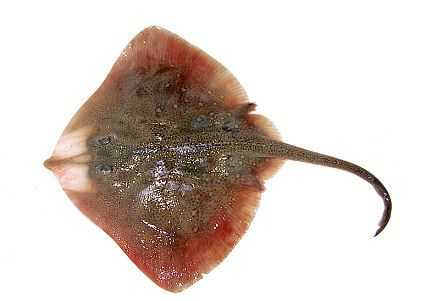Starry Ray

Species Details
Amblyraja Radiata
Rajidae
Rajiformes
Inshore
15 - 25 lbs.
20" - 41"
Starry Ray (Amblyraja radiata) Fish Description
Also known as Thorny Skate, Thorny Back, Thornback, Starry Skate, Miller, and Maiden Ray, the Starry Ray is a member of the Rajidae family.
The Starry Ray has no dorsal nor anal spine. Its body is shaped like a rhomboid; juveniles have a rounder shape, however. The tail of the Starry Ray is shorter than its body; it has 10 large thorns. Its shoulders also have two or three large thorns. It has a snout that is stiff, short, and bluntly triangular. Strangely, the Starry Ray’s upper surface is very rough due to the solid thornlets scattered all over it. A row of large thorns numbering 13 to 17 lines its nape up to the dorsal fin.
Diet & Size
Starry Rays love to feed on bony fish and crustaceans. They also like amphipods, decapods, polychaetes, herring, redfish, haddock, cod, finfish, eel, anemones, shrimp, and crabs. The average length of Starry Ray is 34 inches; its weight can reach up to 25 pounds. It is reported that their maximum lifespan is 28 years.
Interesting Facts About the Starry Ray
- The Starry Ray’s scientific name came from the Greek word amblys, meaning ‘darkness’, and the Latin word raja, meaning ‘ray’.
- Starry Rays pair with another through an embrace.
- This oviparous species can lay 10 to 45 egg cases each year.
- Starry Rays produce egg capsules which hatch outside the body; each egg capsule is 1 to 4 inches long and 1 to 3 inches wide.
- The Starry Ray has a diamond-shaped pectoral disk.
- Unlike other rays, the Starry Rays do not have venomous spines which are harmful to humans.
- Starry Rays may look similar to flatfishes, but they are more closely related to sharks.
Starry Ray — Fishing Techniques
Commercial anglers capture Starry Ray using seines. They haul them in using seining ropes. Bottom-trawls is another common technique for fishing Starry Ray. Sometimes, inshore vessels target Starry Rays with longlines and tanglenets.
The IUCN tagged Starry Ray as Vulnerable. The National Marine Fisheries Service labeled it as a “Species of Concern”. Usually, Starry Rays are caught as bycatch in otter trawls; they are usually discarded in the process. Due to its status, it has been included in the cod recovery plan which aims to reduce bycatch of this species.
Starry Ray habitats are in danger due to otter trawls which cause significant damage.
Habitat and Distribution
The Starry Ray is a demersal, oceanodromous, marine fish species thriving in brackish and salty waters measuring 1,400 feet in depth. They thrive in waters with temperatures ranging from 30 °F to 57 °F and at depths measuring 66 feet to 3, 281 feet.
This species is abundant in the North Atlantic waters as well as the neighboring Arctic parts. They span areas from Svalbarg, Greenland and Iceland up to the English Channel. Starry Rays also thrive in the western part of the Baltic Sea and the northern part of the North Sea. They encompass waters from Greenland and Canada up to South Carolina in the US.





